Matt Frankel, The Motley Fool
4 min read
In This Article:
-
The Vanguard S&P 500 ETF tracks the performance of the most popular stock market benchmark.
-
It has minimal expenses and has historically been a great way to build wealth over long periods.
-
The S&P 500 has become a little top-heavy, so I prefer an equal-weight approach.
-
10 stocks we like better than Invesco S&P 500 Equal Weight ETF ›
High Yield Savings Offers
Powered by Money.com - Yahoo may earn commission from the links above.The Vanguard S&P 500 ETF (NYSEMKT: VOO), also known by its ticker symbol VOO, is one of the most popular funds in the world. Including Vanguard's mutual fund version of the same index fund, investors have $1.4 trillion in assets invested in it.
As the name suggests, this is an index fund that tracks the benchmark S&P 500 (SNPINDEX: ^GSPC) over time. In other words, if the S&P 500 produces a 20% total return for investors over the next two years, this ETF should do the same, net of fees.
Speaking of fees, as a Vanguard ETF, the investment expenses of this index fund are extremely low. It has an expense ratio of just 0.03%, which means that for every $1,000 in assets, your annual investment cost will be just $0.30, which will be reflected in the fund's performance over time.
The Vanguard S&P 500 ETF is generally thought of as an excellent "core" investment for a stock portfolio. And in full disclosure, I own shares of it in my own retirement portfolio. But if I were to put new money to work today, I may choose to go in a slightly different direction and buy shares of a similar ETF that has one big difference.
To be clear, the Vanguard S&P 500 ETF is a great index fund. If you're simply looking for a low-cost way to match the stock market's performance over time, it could be an excellent addition to your portfolio.
My biggest issue with investing in the S&P 500 is that it has become rather top-heavy in recent years. With the emergence of trillion-dollar tech companies, the S&P 500 is weighted so that well over one-third of its performance is derived from the 10 largest components.
In a nutshell, an S&P 500 index fund has increasingly become a bet on the largest few dozen U.S. companies, and has become less of a broad, diversified way of getting stock market exposure.
If I were putting new money to work today, I would take a closer look at the Invesco S&P 500 Equal Weight ETF (NYSEMKT: RSP). It invests in the same 500 companies you'll find in the portfolio of the Vanguard S&P 500 ETF, but with one key difference.













